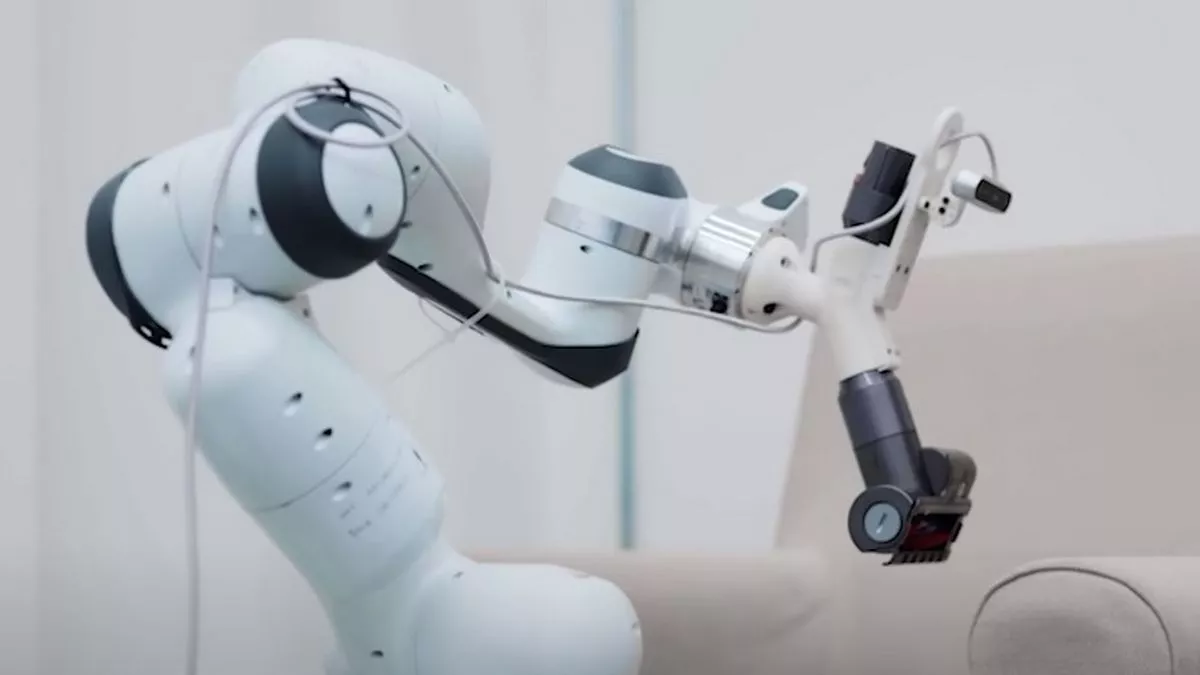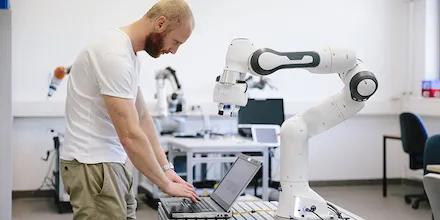In the world of robotics, the development of advanced control systems has revolutionized the capabilities of robotic arms. These versatile machines have evolved from simple manual controllers to sophisticated automated systems, enabling precise and complex operations across various industries. In this blog post, we will explore the journey of robotic arm control systems, tracing their evolution from manual control to the highly advanced operations of today.
Manual Control Systems: The Foundation
The early stages of robotic arm control relied heavily on manual control systems. Operators would manipulate the robotic arm through physical interfaces, such as joysticks or control panels. While this approach allowed for basic movements, it required constant human intervention and lacked precision and repeatability.
As technology progressed, so did the control systems. The introduction of computer interfaces allowed for more precise control, enabling operators to program and repeat specific movements. However, these early control systems were limited in their capabilities, and the full potential of robotic arms remained untapped.
Sensing and Feedback Systems: Enhancing Control
The integration of sensing and feedback systems greatly enhanced the control capabilities of robotic arms. Position sensors, such as encoders or laser trackers, accurately measure the arm’s position and orientation in real-time. Force sensors, on the other hand, provide information about the forces applied during interactions with objects.
By combining these sensors with advanced control algorithms, robotic arms can adjust their movements based on the feedback received. For example, if a robotic arm encounters an unexpected obstacle, the force sensors can detect the resistance and trigger the control system to modify the arm’s trajectory or exert a different amount of force.
Sensing and feedback systems also play a crucial role in ensuring safety. For instance, if a human operator comes into contact with the robotic arm, force sensors can detect the excessive force and trigger an immediate stop to prevent injury.
Moreover, the integration of vision systems with robotic arms further enhances their sensing capabilities. Cameras and depth sensors enable robotic arms to perceive and interpret their surroundings, allowing for more precise object recognition and manipulation.
In manufacturing, sensing and feedback systems enable robotic arms to perform intricate tasks, such as assembling small components or welding with high precision. They can also adapt to variations in the production environment, ensuring consistent quality and reducing waste.
In healthcare, robotic arms equipped with sensing and feedback systems can assist surgeons during complex procedures. They can provide steady and precise movements, reducing the risk of human error and improving patient outcomes.
Furthermore, sensing and feedback systems have paved the way for collaborative robotics, where humans and robots can work together in a shared workspace. Force sensors and vision systems allow robotic arms to detect the presence and movements of humans, ensuring safe and efficient collaboration.
Looking ahead, the continued advancements in sensing and feedback technologies will further enhance the capabilities of robotic arm control systems. Integration with artificial intelligence and machine learning algorithms will enable robotic arms to learn from the feedback received and continuously improve their performance.
In conclusion, These systems enable precise movements, adaptability to changing environments, and ensure safety during interactions with humans.
Programmable Logic Controllers (PLCs): Automation Takes Root
The advent of programmable logic controllers (PLCs) marked a significant turning point in the automation of robotic arm control systems. PLCs provided a centralized control unit that could execute complex sequences of commands, making it possible to automate repetitive tasks.
PLCs allowed for the creation of programs that defined the robotic arm’s behavior based on specific conditions and inputs. This eliminated the need for constant human intervention, streamlining production processes and increasing efficiency. Robotic arms equipped with PLC-based control systems could now perform tasks autonomously, improving productivity and reducing human error.
Advanced Algorithms and Artificial Intelligence: Unleashing Automation
The integration of advanced algorithms and AI in robotic arm control systems has revolutionized automation. These systems can now analyze vast amounts of data and make intelligent decisions, enabling robotic arms to operate autonomously and perform tasks with a higher level of sophistication.
One example of advanced algorithms in robotic arm control systems is computer vision. Through image processing and deep learning techniques, robotic arms can recognize objects, identify their characteristics, and determine the best approach for manipulation. This capability is invaluable in applications such as picking and placing things in manufacturing or assisting in surgical procedures.
Path planning algorithms are another critical component of advanced control systems. These algorithms enable robotic arms to calculate the optimal trajectory to reach a target, considering factors such as obstacles, joint limitations, and energy efficiency. This ensures smooth and efficient movements, even in complex environments.
Furthermore, AI algorithms can enable robotic arms to learn from experience and adapt their movements based on feedback. Reinforcement learning techniques allow robotic arms to improve their performance through trial and error, refining their movements and optimizing efficiency over time.
The integration of advanced algorithms and AI also facilitates human-robot collaboration. By understanding human intentions and behaviors, robotic arms can anticipate and respond to human actions, ensuring safe and efficient cooperation in shared workspaces. This opens up new possibilities for applications in industries such as logistics, healthcare, and manufacturing.
Moreover, the combination of advanced algorithms and AI with other technologies, such as IoT and cloud computing, amplifies the capabilities of robotic arm control systems. Real-time data exchange, remote monitoring, and cloud-based analytics enable continuous improvement, predictive maintenance, and optimization of operations.
In conclusion, the integration of advanced algorithms and AI in robotic arm control systems has unleashed a new era of automation. These systems can interpret complex data, learn from experience, and make intelligent decisions, enabling robotic arms to operate autonomously and perform tasks with greater precision and efficiency. With ongoing advancements in algorithms and AI, the future of robotic arm control systems holds immense potential for further innovation and expanded applications in various industries.
Collaborative Robots: A New Era of Automation
Collaborative robots revolutionize automation by promoting safe and efficient human-robot collaboration. These robots have advanced sensors and control systems that enable them to detect and respond to human presence and movements, making them suitable for industries where close interaction with humans is necessary. Cobots find applications in assembly lines, healthcare, and logistics, among others.
The control systems of collaborative robots prioritize user-friendliness and intuitive programming interfaces. This allows non-experts to easily interact with the robotic arm, expanding the range of users who can benefit from this technology. Collaborative robots represent a new era of automation where humans and robots work together seamlessly, unlocking new levels of productivity and efficiency.
In manufacturing, collaborative robots can assist human workers in tasks that require strength or precision. They can handle heavy materials, perform repetitive tasks, and even provide guidance through augmented reality interfaces. This collaboration enhances productivity, reduces the risk of injuries, and allows human workers to focus on more complex and creative aspects of their jobs.
In healthcare, cobots can support medical professionals in various ways. They can assist in surgeries, providing steady and precise movements for delicate procedures. They can also handle and transport medical supplies, reducing the strain on healthcare staff and improving overall efficiency.
In logistics, collaborative robots can optimize warehouse operations by working alongside human workers to pick, pack, and sort items. They can navigate through crowded spaces, adapt to changing layouts, and assist in inventory management. This collaboration improves operational efficiency, reduces errors, and enables faster order fulfillment.
Collaborative robots also have the potential to contribute to other industries such as agriculture, hospitality, and retail. Their versatility and adaptability make them valuable assets in various applications where human-robot collaboration is beneficial.
As technology continues to advance, collaborative robots will become even more sophisticated. They will have enhanced sensing capabilities, improved dexterity, and increased autonomy. This will enable them to take on more complex tasks and work alongside humans in even more challenging environments.
The Future of Robotic Arm Control Systems
As technology continues to advance, the future of robotic arm control systems holds exciting possibilities. We can expect further integration of AI and machine learning algorithms, enabling robotic arms to learn and adapt more effectively to their environments. Control systems may become more decentralized, allowing for distributed intelligence and coordination among multiple robotic arms.
Additionally, advancements in haptic feedback and virtual reality interfaces may enhance the teleoperation capabilities of robotic arms, enabling operators to control them remotely with a high degree of precision and dexterity.
In conclusion, the evolution of robotic arm control systems has transformed the capabilities of these machines, enabling them to perform increasingly complex and automated operations. From manual control to advanced AI-powered systems, the progress in control technology has paved the way for the widespread adoption of robotic arms in various industries. With further advancements on the horizon, we can expect automated arm control systems to continue pushing the boundaries of automation and revolutionizing the way we work.



